Hey, y'all! We’re going to try to make regular garden-related notes here so that we can look back to see what happened when. A garden journal is handy because it helps you recall when to plant certain things, how different varieties did that year, and what to do (or not do) next year.
See also: Gardening articles in the blog
Note: All references to temperatures are in Fahrenheit.
July 18, 2022
The garden is doing quite well considering how cool a spring and summer we've had this year. My squash plants are ginormous and the peas have been producing for a couple weeks. We've also had a great crop of strawberries. Blueberries are just starting to ripen. The cherries didn't do so well. Green beans are also struggling to get going. The tomato plants all look fantastic and have flowers on them.
Our garden is full of flowers, which the bees are enjoying. All of the brassicas are in full flower - their yellow flowers are pretty - this includes kale, swiss chard, bok choy, broccoli, and some of the spinach. Borage started flowering in the early spring and then another crop of borage appeared and is now just starting to flower. The blue coneflowers are also scattered around the garden again - they all seeded themselves. Bees also have flowers on strawberry plants, peas, squash, tomatoes, etc. So many flowers for them! Earlier in the spring, we didn't see any of our bees in the garden. They were all out on the trees I guess. But, now that the trees are mostly done flowering, the honeybees can be seen on all the flowers in the garden.
We haven't done all that well with lettuce this year. Normally I have a giant patch of it, but this year there are only a few lettuce plants to nibble on. I have more started for late summer and fall. The carrots went to seed before they even had a chance to grow to any size at all. It's strange how some years certain plants do really well while other years the same plant just doesn't grow or produce anything at all.
One plant that has been sustaining us is the beets. We have several nice patches of them in the garden. I was so persistent trying to get them to start because last year they didn't grow at all. We've been eating the beet greens nearly every day. Soon, the beets themselves will be big enough to harvest. We've also been eating potatoes. I start digging them while they're still pretty small, only pulling out enough for a meal every now and then. They are finally starting to get bigger. Yesterday I pulled one out that was big enough to enjoy as a baked potato.
We harvested nearly all the garlic scapes and made garlic scape pesto. I froze the pesto in half-pint jars, just the right size for using on one pizza plus a few other meals where we put it on top of chicken or on toasty slices of bread baked in the oven. I put about 12 half-pint jars into the freezer. We are definitely well stocked when it comes to pesto.
June 15, 2022
I've started doing a new form of weeding and composting. What you do is weed the row and toss the weeds into the aisle. Then you cover the weeds in the aisle with spent straw or pine bedding from the chicken coop. Basically, it's composting within the aisle. Then, as you walk on it, it breaks down faster. Eventually, you can then scoop it up onto the row as finished compost. It also helps keep the weeds down that would otherwise grow in the aisle.
Donor tomato plants are starting to appear here and there in the garden. I've been weeding around them and putting straw down around their base to help retain moisture. I'm looking forward to discovering what kind of tomatoes they are - it could be Matt's Wild Cherry, Yellow Pear, Mortgage Lifter, Roma, Cherry, or Sweethearts. You never know!
May 26, 2022
The two rows of corn that I planted (and replanted) has sprouted. The corn starts look slightly different than the grass that's also growing as weeds all about. It's good to see the corn making its way from the ground. However, there are still no green beans sprouting. And not much squash. And no watermelon or cantelope. Where is everything? Seeds are just not germinating very well. I think it's been too cold here this spring. Maybe in another week or two, but then, will the seeds still be good? I keep replanting stuff. Well, there's still enough time for everything to reach maturity, if things will just get going soon.
Meanwhile, the borage has reseeded itself EVERYWHERE. We will have an incredible amount of borage throughout the garden. I should pull it out, but for now, I'm letting it be. At least until everything else has sprouted.
May 15, 2022
I've decided that once our rhubarb has gone to seed and the seeds have dried out, I'm going to harvest them. Then, I'll start growing rhubarb from seed next year! It takes a few years for the plants to become large enough to harvest anything, but it should be interesting to go through the process. It's sort of like the garlic where it takes a while to get a big harvest. For some reason, these longer-process plants are interesting to me. So much food is possible if you have the patience to wait for it. I believe that the plants I have are Victoria Rhubarb, which is an heirloom variety.
May 10, 2022
I'm really late entering anything here about the garden. However, lots has been going on. The early spring garden is fully planted. Many mature cold-hardy plants have been producing for a long time. The kale and bok choy are flowering (they have beautiful yellow flowers), which the bees love.
Our rhubarb is also flowering and it does this every year. Below are the rhubarb in full bloom.
Last weekend, my husband tilled the parts of the garden that had gotten overgrown with weeds. About 2/3 of the garden is no-dig and I just maintain it. The remaining 1/3 is too much for me to keep up with. I put straw down on the new paths that I dug in the tilled area. Maybe if I can keep up with a deep layer of mulch, the weeds won't get so bad. That is my one area of struggle, is getting enough mulch out there to deeply cover the ground. Our farm doesn't produce enough mulch and so I have to buy it. The two options I'm comfortable with are straw and pine bedding. Since I'm working now, I don't mind the extra cost to buy lots more mulch this year, so maybe the weed situation will be better than last year.
Below is the crazy weed patch that my husband tilled for me.
We're holding off on planting tomatoes and peppers until it gets warmer (the plants are in the sunny window in the house). But, we did plant corn, green beans, and squash in the garden this past weekend.
I also gathered nearly all the red and green tomatoes from outside and sorted them by ripeness. The ones that are green are ripening better in a darkened room than they do in the window. So I've put the green ones in shallow containers and set them on our buffet in the mudroom.
February 9, 2022
Today I planted a few seeds in the garden:
- Tall Telephone Peas (from seeds I saved from 2020)
- Little Marvel Peas
- French Breakfast Radish
- Beets (from seeds I saved from 2020)
I've been working on cleaning up the rows, weeding and putting down more mulch. I also added compost to the rows that have seeds planted in them. There's a ton more weeding to do. I wish I'd put all of our leaves in the garden rather than in the mulch pile, as the leaves would have blocked out the weeds for me. I put them into the mulch pile though, hoping to have them break down into leaf mold, which is a great mulch for putting around vegetables.
October 31, 2021
Happy Halloween! We have had light frost each morning and will have it again tomorrow morning, too. The tomatoes in the garden are toast. It's sad to see them turning a weird yellowish-black as their cell walls burst and the plant sags over. Even the tomatoes have gotten watery inside and are no longer any good. Strangely enough, artichoke is still good and harvestable up through now, though. All of the cool season crops are flourishing. The peas are still doing okay despite the light frosts - the flowers and pods look good and don't seem to mind the temperatures that hover around 31-33 degrees during part of the night.
The pots of tomatoes and squash that I moved up next to the brick wall by the house are doing okay outside. The squash has a flower and a zucchini is forming on it. The tomatoes are lush and green. They like the southern exposure and the warmth of the brick wall that keeps them from getting too cold.
October 12, 2021
Last night we had our first light frost. This is about 4 days earlier than last year; I think last year it was on October 16. Luckily I already transplanted a few tomato, pepper and zucchini plants into pots and put them by the brick wall at the front of the house, where it stays warmer.
In the garden, the cucumber, zucchini and green bean plants have been substantially damaged by the light frost.😢 Their leaves grew very thin and there is a tinge to them that is somewhat black.
I rescued a few small cucumbers from the plants, below. I thought cucumber was more cold-hardy, but apparently not. The few cucumbers look okay though.
Below are the green beans. Their leaves are slightly tinged with black and have gotten thinner, wilting down.
The summer squash plants were also heavily damaged by a very light frost. I picked a few squash from the plants but I'm not sure how good they are. Sometimes the frost can also damage the fruit on the plant.
The ripened tomatoes are in the kitchen. So many tomatoes, and this is just the tail end. We had tomatoes galore and have been making tomato sauce, salsa, pizza sauce, and using them in salads and sandwiches. I canned a bunch of tomato sauce, whole tomatoes, and salsa, too, and put some in the freezer.
August 26, 2021
The weather has been cooling down in the evenings; a few nights recently it's dipped as low as 46 degrees. Too many cooler nights like this can be hard on tomatoes, causing our plants to get tomato blight this time of year. The blight causes some of the leaves of the tomato plants to turn black and a few of the larger tomatoes will get a bad spot on the bottom. Because of this, I tend to pick larger tomatoes as soon as they get any blush of color and then put them on our windowsill in the kitchen to ripen the rest of the way. The cherry tomatoes are unaffected at this time.
About half of our corn was ready to be picked today. I noticed that the ripe ears tended to tilt away from the stalk, whereas those that weren't quite ready held themselves upright and close to the stalk.
Right now, the slugs are under control. Hand picking slugs every day and feeding them to the chickens and ducks has worked to keep their numbers small.
Succession planting is going well. Another round of green beans (bush type) are doing well, with flowers now forming. I also planted more zucchini and they are just starting to get fruit on them. The older summer squash plants have quite a bit of powdery mildew on the leaves. So I'm very glad to see the new plants are going to bear fruit for us. We've been using our summer squash to make zucchini relish, zucchini pineapple, zucchini pickles and canned summer squash. We also enjoy eating fresh zucchini for dinner (just steaming it and then putting some butter on it). And then there is zucchini lasagna, zucchini noodles (spiralized zucchini), chocolate zucchini bread, lemon zucchini bread and fried zucchini. Such a versatile vegetable!
I've canned about 20 jars of green beans. Because I didn't plant an enormous row like in previous years, and instead relied on succession planting, we aren't getting a whole lot at once. Next year, I should plant a long row for canning purposes to make the canning more efficient, while also planting more for fresh eating later in the season.
July 5, 2021
Today we harvested our first small container of blueberries. We also harvested fava beans, peas, raspberries, strawberries, broccoli and zucchini. Our zucchini seems to be producing earlier than usual, likely due to the unusual heat wave that we recently had.
Below is what the fava beans looked like after harvesting and opening the pods.
The smaller bean that's inside also has a protective layer that has to be removed. I blanched the shucked beans for 1 minute and then put them into ice water. After that, the outer layer was easy to remove.June 18, 2021
The fava beans have pods on them now! They grow very differently from green beans. Notice how the fava bean pods stick up from the stalk of the plant:
They look like they are growing upside down.Our blueberry plants are loaded with berries. Even though the plants are still small, since we have about 110 of them we will still have plenty of berries to freeze and give to friends.
The variety of these shrubs are Duke Highbush Blueberry. I mixed organic elemental sulfur into the soil this spring around half of the plants to see how they do. Those that had the sulfur are producing a lot more and look better than those that haven't been treated. It's still early enough in the season that I may go ahead and put more sulfur down on those that were not treated.
June 17, 2021
One trick for germinating seeds when the weather gets warm out in the garden: cover the bed with a thin layer of straw. This will help keep the soil moist so that the seeds can germinate. Once the seeds have germinated (check every couple days), remove the straw covering so that light can get to the leaves. Then once the seedlings get big enough, layer the straw mulch back on there underneath the leaves.
Today I planted lettuce, radish, kale, spinach and beets in the garden, and I put thin layers of straw over each bed to help the seeds germinate. We've had these veggies in the garden throughout the spring, but they are now dwindling or gone as we enter summer. It will be nice to have some more of them later in the season.
May 6, 2021
This time of year we get so busy in the garden and are exhausted at the end of each day that we forget to publish anything in the Garden Journal. Sorry about that! Nearly every day now I am spending between 1-4 hours doing garden tasks, such as planting, weeding, watering, harvesting, pruning, digging and creating new garden beds. Gardening is certainly great exercise!
Here are a few photos of the garden as of today:
The beehives are out at the far end of the garden. We placed them there so that they would be within a fenced area on our property and so we could keep a closer eye on them, since we are out in the garden every day.
One thing we are trying this year is putting big rocks around our tomatoes to help keep the the plants warmer. It's too cool in our region to grow tomatoes very well outside and so we are always trying something different to see what might work.
This year since we had overwintered so many cool season vegetables, our garden was already productive when early spring arrived. While our neighbors are just now planting lettuce, spinach, radishes, carrots and other veggies, we have been harvesting the same produce from our garden. I've been showing our neighbors what we did, and am excited that they are now interested in trying out planting cool season crops for a fall and winter garden based on our experience.
March 27, 2021
Yesterday we noticed that the swifts have started to migrate back to our area. We could a few of them flying around the trees that line Morse Creek in our backyard. Seeing the birds brings back memories of our close encounters with them a few years ago. With the arrival of spring and recent bug hatchings, there are a lot of flying insects for them to eat. It's fun to watch the swifts circle and dip up in the sky. They are appropriately named for the swift way in which they fly.
March 19, 2021
The peas that I planted as seed did not germinate in the garden 😞 nor did the fava beans. I think both needed more soaking prior to being planted. As I dug around in the bed that had the pea seeds, I didn't see any seeds in there, so probably something ate them or they broke down into the soil. So yesterday I went ahead and planted the eight pea starts that I had grown in pots in the house. The starts are about three inches tall and I had moved them outside to the brick flowerbed a couple weeks ago to harden them off. It's supposed to be rainy for the next few days and the temperatures should be above freezing, which should help the pea starts get established.
I also moved the cabbage starts outside to our brick flowerbed where they will stay warm enough to harden off over the next week. Incidentally, the little black bugs that were all over the flowerbed last summer have already returned. I'm not sure what they are. Last year I doused the area repeatedly with neem oil spray and it seemed to help a little bit. A few days ago I sprinkled diatomaceous earth all over the area but they don't seem to be bothered by this. Maybe I will try spraying them with peroxide diluted with water (one cup of water to about a tablespoon of peroxide, mixed in a spray bottle). Plants thrive with the peroxide since it provides them with oxygen, while bugs seem to die off from it.
In the garden, other seeds I planted recently have germinated. Of course, I didn't mark what I planted where, thinking I'd remember. Well, I have forgotten. The only helpful thing I did was put a stake at each end of the bed where seeds were planted so I'd at least know something is planted there. But I think the seeds that germinated are lettuce, radish and maybe bok choy. I guess we will find out once the plants get bigger!
Yesterday I also hooked up the soaker hoses around the blueberry bushes and watered them. It's been a relatively dry spring and these are still young plants so we want to make sure they get enough water. Of course, since I watered them, today it's been raining lightly all morning...I believe that's Murphy's Law, right? I also tested the soil and the pH is still too high, and so we will need to mix some elemental sulfur into the top layer of the soil around each plant. I've been researching sulfur to try to figure out the best option and price, since we have to get enough for 100 blueberry bushes. One other thing I'm doing to help the blueberries is I'm putting more mulch around each plant. This year for mulch we're adding pine straw, which is just pine needles taken from under a few of our trees. Pine needles help acidify the soil as well. In the process of scooping up the pine needles, I'm cleaning out the weeds from the surface. The area under the trees needed to be weeded anyway. Two birds, one stone. I really like that we're reusing something that is already here on the property, rather than buying mulch from an outside source. We also still have quite a bit of peat moss that we purchased last year, stored away in the shop.
March 4, 2021
This morning I fertilized the brussels sprouts and rhubarb using a balanced fertilizer. Then I planted potatoes from last year's crop (I had saved a few for planting in the spring). The ones I planted had sprouted in a big way, sending up shoots a foot long. Apparently potatoes can be planted this early in the spring - we'll see how they do! I usually wait another month to plant them. I also soaked fava beans last night and put them into the ground this morning.
It's supposed to rain today and so I didn't water anything after fertilizing and planting. Seeds germinate better when planted right before the rain and they are kept moist for a week by light rain. So far the sun has been shining...I'm not sure I trust today's weather report. I've been worrying about it all morning. Who ever hopes for more rain in the spring? I must be the oddest person in the whole world.
Temperatures have been just barely above freezing at night, and getting into the upper 40s and low 50s during the day. Good weather for cool season crops.
The garlic bulbils I planted last fall have started to send up green sprouts. It looks like these are doing well after all! I had given up hope on them! They sure took a lot longer to send up their sprouts than the larger cloves of garlic did. It looks like I might have a big harvest of little garlic cloves, for replanting, later this summer. There are hundreds of them!
March 3, 2021
I moved our pea starts outside to harden them off. We have a southern-facing window at the front of our house with a flower bed that is surrounded by brick and a parking lot in front of it. All that brick and pavement means that this space stays a few degrees warmer overnight. I've found that placing starts in this flower bed allows me to leave them there during the night, rather than having to bring them inside and then having to put them back out in the morning like you normally do with starts when hardening off.
Outside, we planted a few more seeds in the garden. Included were:
- Lettuce (a variety called "Salad Bowl Green Lettuce" that has curly edges)
- Bok Choy
- Radish (a variety called "Rudi")
- Fava Beans
After planting the fava beans, I was reading that they needed to be soaked for 12-24 hours first. Oops. Well, I didn't plant all of the fava bean seeds that I have, and so I will soak the rest and add them to the same garden bed.
I also went to Sunny Farms and bought our honeybees. Yay! I bought two packages of Italian honeybees, which is enough for two hives. There will be 10,000 bees in each colony along with one queen each. We will be able to pick them up on Saturday, April 24.
February 24, 2021
Today I pruned the pear and apple trees. These are really old trees, and so I've taken a gentle approach to pruning so as not to shock them. I lightly pruned focusing on any water sprouts (branches that grow straight up from the trunk), damaged or dead limbs, and crowded areas to allow more sunlight and air to get into the center of the tree canopy. I ended up removing a big tree limb from the plum tree because it was shading the pear tree. The plum tree has already started to get buds on it. So I took a few of the smaller flowering branches that came down with the big limb, and cut those off and put them into a vase in the kitchen window.
Pear flowers are toxic to cats. Since our cats don't get up this high and don't go on the kitchen counters, the pear branches should be safely placed to avoid any kitty illness. We'll have to be diligent to throw away any pear flowers that fall so they don't end up getting onto the floor. I'm amazed how many things are toxic to cats - it's pretty much everything that grows! So we put our plants and garden starts up where the cats don't explore to try to keep them safe.
The seeds I planted in the garden window on February 7 have germinated and are ready to go into bigger pots. I cleaned the pots that I used last year using a bleach and water solution, then rinsed them really well before re-using. I also did the same with the few seedling trays that I have, which I'll put under the pots to catch any water that seeps through the pots. Cleaning the pots should help prevent plant diseases and bugs. I transplanted about half of the seedlings today, focusing on the bigger ones. Our garden window has a nice mix of greenery and flowers in it. It's hard to get a good picture due to the sunlight coming in the window, even though it's a cloudy day! I stood up on the stool to try to get a photo showing several shelves...
February 23, 2021
Planted an apple tree in the front yard near to the giant old Winter apple tree. The new tree came from Costco. It’s about 6 feet tall and has already started to bud and bloom, so we’re hopeful it will have enough of a head start to survive. It’s a combo tree that has branches from four different apple varieties grafted onto it. Planting it and surrounding it with fencing was an awkward chore as it’s been a rainy and blustery day with intermittent sunshine. I’m sure I looked ridiculous out there sliding around in the mud while trying to get the tree into the ground, but I didn’t want to put it off and wait for better weather because the tree has been sitting in the garage already for a couple of days.
Also planted peas in the garden (from seeds, not starts). We have pea starts growing in the garden window as well, in case the seeds don’t do well.
February 19, 2021
The pepper plant that I brought inside from the garden last fall is doing very well! So well in fact, that I took two cuttings from it today, to see if we can propagate new starts. I cut off two small, healthy-looking side branches, cutting them off at 45-degree angles. Then I trimmed off several leaves from each branch and put them into a small glass of water. I stirred a tiny amount (maybe 1/8 teaspoon) of rooting hormone into the water to give it a boost. It will probably take several weeks for the branches to form roots, assuming that they even will do so.
Here is a photo taken today, of the pepper plant that I brought inside last fall:
When I first brought it inside, the plant was very small. It had been hiding underneath a huge swath of beautiful blue cornflowers that had overtaken a row in the garden, and so it didn't have a chance to grow very big. When I ripped out the cornflowers in late October, I found it. The cornflowers had sheltered the pepper plant from the cold, and so it wasn't damaged by the first frost at all. I was stunned to see it there. It was too nice a plant to leave outside, and so I dug it out of the ground, gently tapped off as much of the "outside" dirt as I could, and then put it into a small pot with some "clean" potting soil (in other words, bagged dirt that can be used for indoor and outdoor plants). To help make sure no bad outside organisms ended up taking over the plants in my garden window, I lightly sprayed all the plants and the soil occasionally with a mixture of 1 teaspoon hydrogen peroxide with 1 cup of water, which I keep in a spray bottle near to my indoor plants. This also helps with gnats that sometimes appear. Other than watering it and putting a little fertilizer on it in December, all the help it's had is just getting full sun in the garden window. The pepper plant has grown twice as tall since then, exceeding the height of the shelf. It actually leans out over the side of the shelf and is going up the next level. As a result, the plant has a curve to it. I've re-potted it into a larger pot as well.
Below are the two cuttings that I took from it. These are placed in the kitchen window.
The only thing I'm not 100% sure about is what kind of pepper plant this is. Based on the pepper seeds I have in my seed box and the type I started last year, I'm pretty sure it's a serrano pepper. Although, a friend planted several pepper plants in our garden, and so it's possible it could be one of those, but not very likely based on the location.
Serrano pepper is a hot chili pepper. The plants bear green fruit that turns red when fully ripe. Due to our cooler weather, the peppers usually don't turn red before I end up having to pick them. Two years ago, I grew pepper plants that bore about 80 or more small green peppers, which were probably this same thing. I froze most of them in a zip lock bag. They added a nice heat to chili and soup. We just used up the frozen peppers a few weeks ago. I miss those hot peppers. We're hoping to have a good sized harvest of hot peppers this summer so we can freeze a bunch more.
February 14, 2021
Happy Valentines Day! The ducks started laying eggs again after taking a break for most of the winter. The eggs of an Indian Runner Duck are greenish blue and look similar in size and color to a White Ameraucana chicken's egg. In fact, it's really hard to tell the difference between the duck and chicken egg. Below is a duck egg on the left and a chicken egg on the right.
February 7, 2021
Today we started some of our garden seeds in the window. We're using recycled plastic containers that used to have tomatoes in them that we bought at Costco. These containers work great because they have lids and they are clear, allowing sunlight to enter if the lid is partly closed.
Two of the recycled containers contained boat parts that my husband bought. Might as well put these containers to use, and save having to buy new seedling trays. All my seedling trays from prior years were worn out.
The list will be kept near to the seedlings so that we don't get confused later on. The seedling containers are sitting on a seedling heat mat and the lids are propped slightly open so that too much condensation doesn't form inside (too much condensation can lead to mold growth). By the way, if mold does grow on seedling starts, you can spray them with a mixture of water and hydrogen peroxide. Simply fill a clean spray bottle with 1 cup of water and 1 tablespoon of hydrogen peroxide. Spray thoroughly and the mold will go away. You can also spray plants and soil with this mixture if they have gnats on them to kill the gnats. Hydrogen peroxide will add oxygen to the plant as well, which the plant loves. You often need to spray the soil as well as the plant itself. I have sprayed all of our house plants and starts with this mixture and so far nothing has gotten damaged. The plants seem to do better with it!
January 20, 2021
Finally, I found a moment to sit down and make a list of what we ordered from Deep Harvest Farm. We also seed saved from prior years' gardens, and so our seed order filled in gaps for what else was needed. The order included:
- Winter Squash: Oregon Homestead Sweet Meat. This is an heirloom variety that produces 10-20 pound fruits with blue skins and sweet orange flesh.
- Winter Squash: Butternut Early Remix, 2-5 pound fruits, great for northern growers.
- Cabbage: Primax, produces early, 2-4 pound heads with small core.
- Carrots: Scarlet Nantes and Hilmar
- Cucumber: Marketmore 76
- Snap Bush Beans: Lewis, early maturing plants with 6 inch deep green beans that produce for weeks on end.
- Snap Bush Beans: Bean Scene, a blend of green, violet, yellow and magenta streaked bush beans. This will give us a chance to try out something new.
- Bush Dry Bean: Rockwell, an heirloom from Whidbey Island. Early white bush beans with maroon speckles. We have never harvested and stored our own dry bush beans before, and so this will be a new experience for us!
- Sweet Corn: New Mama, an extra early variety that is very sweet. I have high hopes.
- Bok Choy: Prize Choy, which we selected because they are bolt-resistant.
- Tomato: Moskvich, heirloom deep red fruits, 4-6 ounces, that produces very early for cool climates. Hoping to get lots of big red tomatoes for freezing and canning.
- Cherry Tomato: Gardener's Sweetheart. I selected these because the plant produces 18" long trusses loaded with fruits that are heart-shaped. It also says the fruits don't tend to split. These will be for eating fresh.
- Green Leaf Lettuce: Snowflake, a wavy, lime-green lettuce with mild flavor.
- Bibb Lettuce: Cegolaine, a green lettuce with red edges. Bolt resistant.
- Butterhead Lettuce: Optima, a dark green lettuce with velvety texture and buttery flavor. Disease and bolt resistant.
- Kale Club: a mix of Lacinato, Siberian, Red Curly and Russian kales.
- Zinnia: Salmon Rose. We love growing flowers in the garden for their beauty and because they attract pollinators.
January 18, 2021
Today my daughter and I moved a cattle panel arch in the garden. The soil was soft enough, thanks to all the rain we had last week, to make the chore relatively easy. We also transplanted sage, broccoli and cilantro from an overgrown area of the garden into the part of the garden that has been cleaned up.
The chickens laid 6 eggs today, which is quite an improvement over the past month, when they had slowed their efforts down to maybe 2-3 eggs a day. We froze four dozen eggs during the summer for using during the holidays and when we knew we'd have fewer fresh eggs this winter. The frozen eggs have substituted perfectly in breakfast casseroles, pumpkin pie, and other baked items. Eggs are very easy to freeze; all you do is break them into a bowl, break the yolks and beat the eggs just enough to combine the yolk and white very well (similar to the way you would when making scrambled eggs), and then pour the raw eggs into a freezer container. I like to freeze the eggs using ice cube trays, and then put the frozen cubes of egg into a freezer bag - that way I can pull out only as much eggs as needed for cooking with, keeping the rest frozen for later. One tip if you try this: use a silicone ice cube tray. The eggs get really, really hard when frozen, and so they can be difficult to remove from a tray that has hard sides.
January 15, 2021
The basil and catnip seedlings germinated, and so I put the peat pods into little pots of dirt in the garden window. The apple and pear seeds haven't germinated; I think I'm doing something wrong but have been too busy to try to figure it out.
January 5, 2021
Today I started a few seeds in the window of the Corral (our family room, which has a warm southern-facing window). I started the seeds using peat pellets, since I've had very good success using these in the past, and I put them in a plastic muffin container (so it would be inside a domed container) and set the whole thing on a seedling heat mat. The seeds include:
- Basil. I'm going to grow these in the house for using in cooking. Wish I'd started some sooner.
- Catnip. Some nibbles for our kitties...
- Apple and pear trees.
My dad had great success starting numerous apple trees using seeds from apples he'd gotten at the grocery store. He planted a few of the trees in his yard and gave the rest away to neighbors and friends. This past fall, he harvested apples from the trees! Since he did so well with those apple seeds, I thought I'd give it a try with both apples and pears. The seeds came from organic fruit we had purchased from Costco. Will the seeds germinate? Will we have fruit? I can't wait to find out.
Our weather has still be in the upper 30s and 40s with lots of rain. The creek behind the house is swollen and rushing hard. Landslides and flooding in some areas a bit further away.
January 4, 2021
Before placing our seed order for the year, I went through our container of seeds and organized everything. We have been seed saving as well as purchasing heirloom seeds.
Last year, we ordered seeds from Baker Creek Heirloom Seeds (rareseeds.com), which is a great source for a wide variety of seeds. Their seeds come from farms all across the U.S. Currently, they have closed their online store because they are overwhelmed with orders. I decided to try to source local seeds and so I placed my seed order with Deep Harvest Farm (deepharvestfarm.com), which is located near to us on Whidbey Island. Thankfully they weren't too overwhelmed yet and were able to accept my order. Covid has a lot of gardeners (likely including many more newer gardeners than ever before) panicked and placing their orders now. If you're not able to get an order placed with one of the larger companies, try small local seed companies - search for one near you on Google.
I still need to order seed potatoes and onion starts, but haven't yet decided where to order those.
January 3, 2021
People have been cutting across our field to go to the community barn. There's a community trail that they can follow that would prevent them from trespassing, but for some reason they take a shortcut across our property. We think there are about 15-20 people doing this every day. A few of them have young kids, and as they walk through our land their kids sometimes pull on the plastic netting of the garden fence, causing it to sag and then unfortunately deer can get into our garden. We've seen this happen from the front window of the house, and stand there scratching our heads wondering what would compel parents to trespass and allow their kids to mess with our garden. Later this winter, we're planning to put beehives in the field next to the garden, which makes it a challenge if people are going to be trespassing. We'd like people to stay on the community trail - it's only a short distance more before the trail takes them right to the barn. So, we looked into the cost of putting a fence around the perimeter of our property. It would cost about $1700-1800 for field fence or barbed wire, and about $10,000 for a wood lap rail fence. Until we decide what to do about fencing, we pounded four t-posts into the ground and hung "Private Property - No Trespassing" signs in that area, hoping to deter folks and make them aware they're actually no longer on community-owned property.
January 1, 2021
It's been in the mid-40s for the past two weeks, dipping down into the upper 30s at night. Lots of rain. Still not much going on in the garden. I wish I had planted our cool season crops about a month earlier. The plants we have are all on the small side. Apparently they become almost dormant this time of year, so the size they are at first frost is about where they will be all winter. Next summer, it may be a good idea to start the cool season crops indoors and put out nice-sized starts in early September. This would give them a chance to get big enough to provide a good harvest over the winter. Also, starting a lot more lettuce would have been great!
There are a number of outdoor projects we will be starting soon, including:
- Putting a field fence around the entire perimeter of the property that isn't already fenced (about 1,000 feet of fence)
- Building a greenhouse out of old windows and reclaimed fence boards
- Setting up new strawberry beds using several raised bed frames we got for free
- Moving the chicken pen to be adjacent to the garden and building a new coop
- We're discussing getting pigs and goats and would need to build a fenced area for them
Lots of work to do this winter!
December 23, 2020
High of 41 and low is 30 today. The entire backyard and the chicken/duck area are still frozen with snow but the front yard is melting. The duck swimming pool is out of commission until it warms up. Ducks were swimming in the water bowls. Had to refill their water midway through the day because it was so muddy.
Flowers are still blooming on the tomato plant that's near the front door and cherry tomatoes are ripening on it; hard to believe this plant has survived outdoors so long, but this spot gets full sun and is surrounded by a brick wall. I broke down several giant cardboard boxes and lined the garden pathways with it (makes a great weed barrier). I also buried kitchen scraps and wood ash in the garden (in-situ composting).
December 22, 2020
The snow froze last night and was very crunchy this morning. Ice patches everywhere. About 32 degrees outside in the a.m., warming to 43 by midday. Bright clear skies.
Chicken water dishes were iced over and the duck pool was icy. Animals are all doing fine though; they don't mind the cold weather.
The cherry tomato plant next to the front door is flowering again. It's full of green tomatoes that are very slow to ripen. Need to plant more tomatoes next year next to a brick wall with southern exposure and an overhang, as this type of setting has done exceptionally well for this tomato plant.
I had moved a pepper plant into the house from the garden this past October, before the first frost. It's doing very well, has grown about 4 inches taller. Will need to repot it soon. Put fertilizer (in water) on all the house plants including the pepper plant.
Started microgreens in the window of the Corral.
December 21, 2020
Today is the Winter Solstice and it was also our first snow this season, following a couple days of heavy rain. We had about an inch of slushy snow accumulate by late afternoon. Chickens stayed inside their covered coop. When putting them away at night, had to move 5 chickens over from the unsecured area into the secure coop; these 5 hens didn't want to walk across the snow to get to their roost on the other side, poor girls. I carried them to their roost so they'd be safe and warm with the other hens.
Watered the sweet potato slips that I saved from the garden. The slips are laying in a pot of peat moss in the laundry room. Every once in a while I put a little bit of water on them to keep the peat moss moist. Apparently, these slips can go in the ground in the spring and will grow new sweet potato plants.
Nothing happening outside in the garden today due to snow. Temps in the 30s all day.
December 20, 2020
We've been putting manure compost on the blueberry plants and weeding around the blueberries. Two rows are done. Three more rows to go. Will work on a row a day, during clear weather, until done...probably take another week or two.
We also put manure on the garden (the empty rows that are prepped for it). Burying kitchen scraps directly into the garden along with wood ash from the fireplace, rather than putting it into a compost pile...because, well, my compost pile never seems to make it into the garden! I got the idea from Self Sufficient Me, a youtuber in Australia.






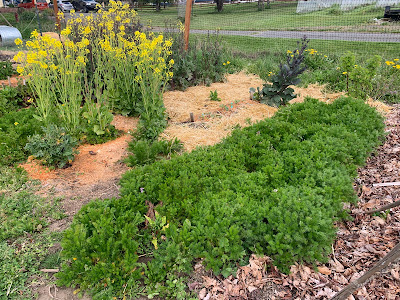
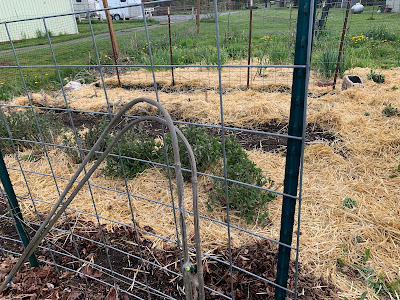

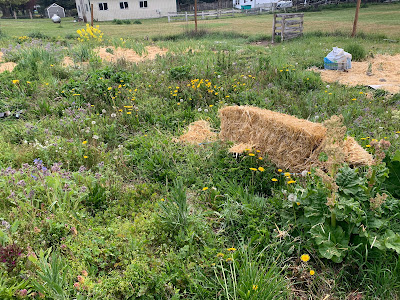




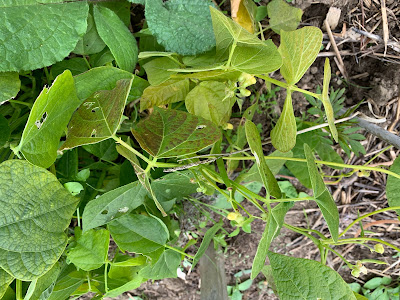



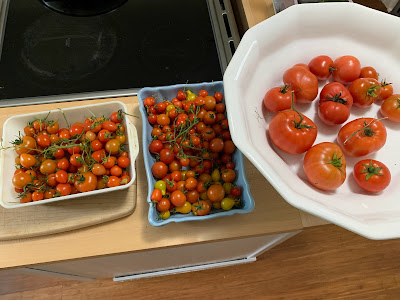


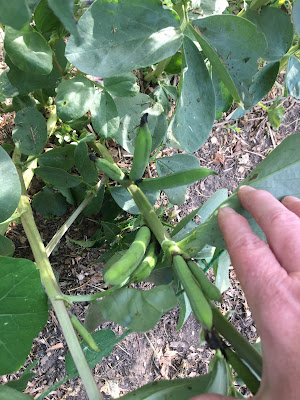




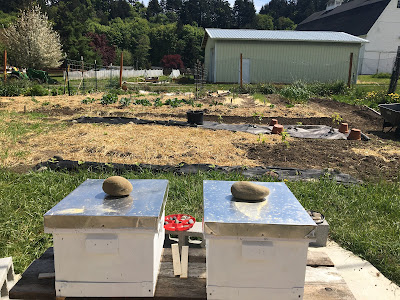






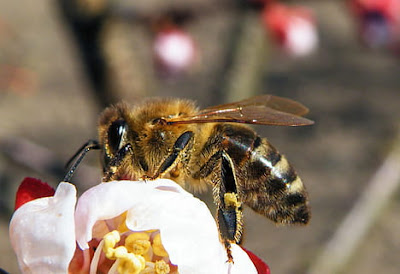











Comments
Post a Comment
Thank you so much for submitting a comment! All comments are reviewed by our moderator before being posted to the blog, in an effort to help control spam.